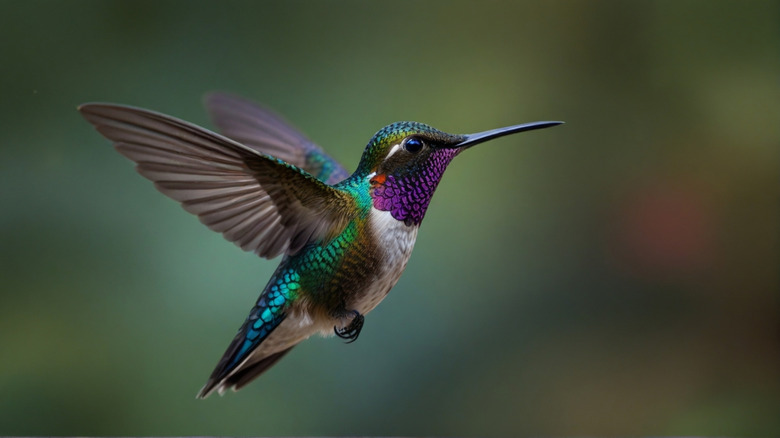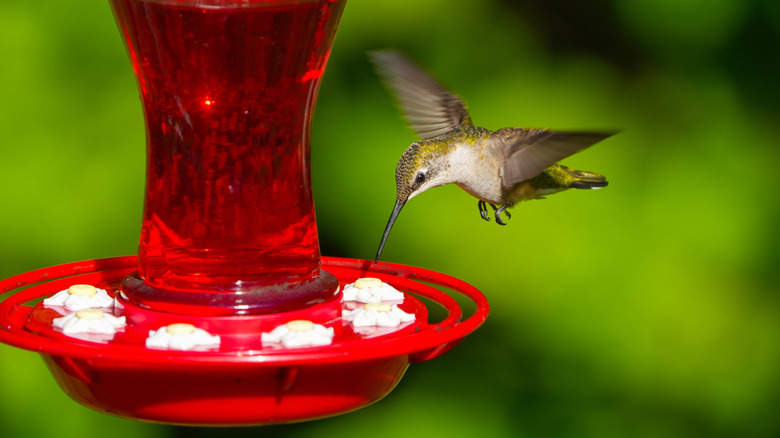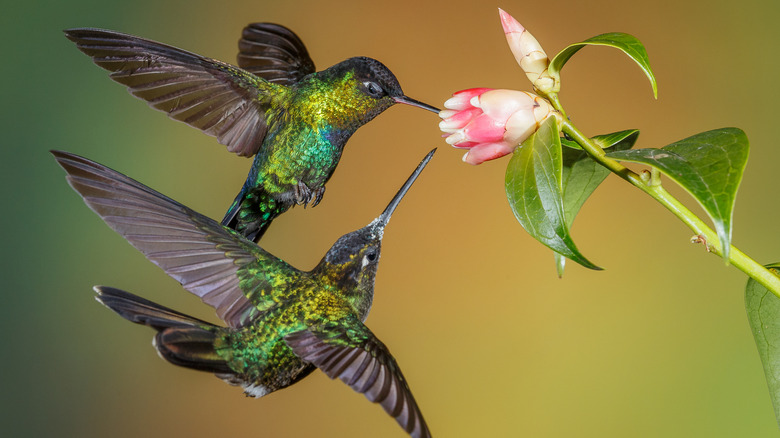The One Color To Instantly Invite More Hummingbirds To Your Garden
Did you know there's one color that will instantly invite more hummingbirds to your garden? Indeed, there's a reason that red shows up on just about every hummingbird feeder, and it's not just aesthetic. Hummingbirds are attracted to red because it's a reliable visual cue for their food. Their eyesight is tuned to spot it quickly, and many of the flowers that rely on pollination from these tiny birds have evolved with crimson petals to stand out against the foliage.
That's why it's the hue of most hummingbird feeders, and the shade some retailers suggest coloring the sugar water mix to fill them. However, the appeal of red goes beyond simple contrast. It often correlates with high-sugar nectar content, which helps fuel a hummingbird's rapid metabolism and long flights. That's why adding swaths of red blooms to your garden such as bee balm or red salvia can be an instant invitation for more hummingbirds to visit.
Of course, color isn't the only thing that draws them in. Hummingbirds are curious and highly visual, and they'll investigate anything that resembles their favorite food sources. Soft garden décor in the right shade can be just as effective as flowers. Even attracting more hummingbirds with an underrated garden accessory they love holds water when you consider how red items like swings, wind chimes, or even red ribbons can act as lures. The birds will come to check it out, and if nearby feeders or nectar-rich blooms are available, they will definitely stick around.
Go vibrant to invite more hummingbirds to your garden
Red may be a hummingbird's favorite color, but hummingbirds aren't solely one-dimensional when it comes to identifying vibrant hues. In fact, depending on the time of year and the region, some of these birds will show equal interest in vivid orange or deep magenta blossoms, if they offer an easy feeding opportunity. What matters more than the hue is nectar quality. If your garden offers plenty of tubular blooms with high sugar content, the birds will come, regardless of whether every flower fits the stereotypical red profile.
Planting in layers also helps: Tall red bee balm above, mid-height coral honeysuckle in the middle, and low-lying fuchsia or impatiens below create a buffet that appeals to different foraging behaviors. Knowing which birds are showing up in your yard can help refine your garden even more. Depending on where you live, you might spot ruby-throated, rufous, or black-chinned hummingbirds, each with slightly different feeding habits.
Learning to identify the different types of beautiful hummingbirds you might find in your backyard gives you a leg up in tailoring your layout. For example, if you notice calliope hummingbirds, which prefer lower blooms and brushy areas, you can lean into ground cover and red flowering shrubs. Still, while red remains the standout color for hummingbirds, research confirms that it's the combination of color, nectar concentration, and flower shape that truly guides hummingbird feeding behavior in the end.
Getting results without risking hummingbird health
Once you've dialed in the color palette, the next step is optimizing your garden setup to support repeat visitors. Grouping plants together helps birds conserve energy while feeding, and choosing native species ensures they're getting nectar that's appropriate for their diet. If you supplement with feeders, skip the commercial formulas that contain dyes or preservatives. A simple homemade mix — four parts water to one part plain white sugar — is not only sufficient, it's preferred. It mimics the sweetness of natural nectar and keeps things safe for these incredibly delicate creatures. Also, don't underestimate the power of consistency. Keeping feeders clean and filled will turn your garden into a regular stop on their route.
Be sure to avoid shortcuts that might do more harm than good, however. Although it's tempting to assume color alone will do the job, adding red dye to nectar is one thing you should never put in your hummingbird feeder. Artificial dyes offer no benefit and may even cause digestive issues or toxicity in birds over time. Instead, lean into naturally red elements in your garden while keeping the nectar itself clean and clear.
Pair this with clever placement and you've got a formula that will truly work. You can even follow a few genius tips and tricks to attract more hummingbirds to your garden, like using red-tinted plant markers or adding shallow water features to complete the habitat. The result? A garden that's not only gorgeous but alive with hummingbirds.


